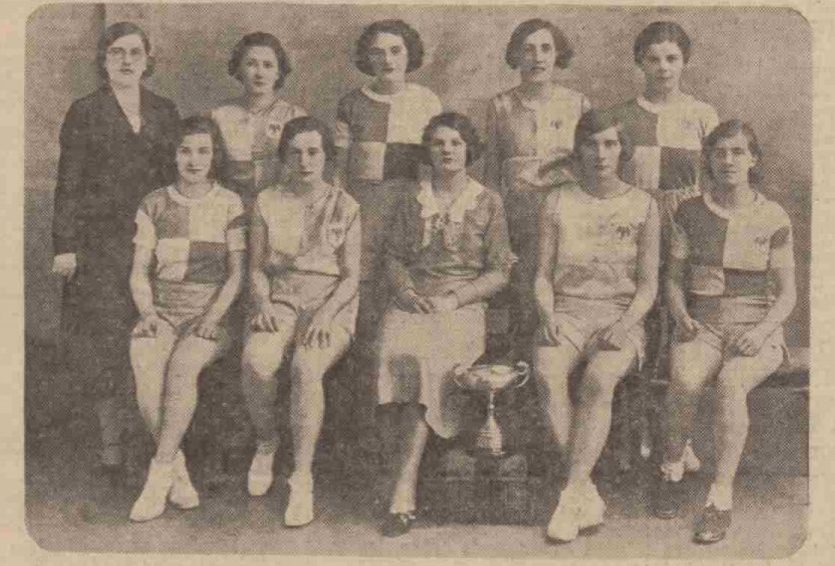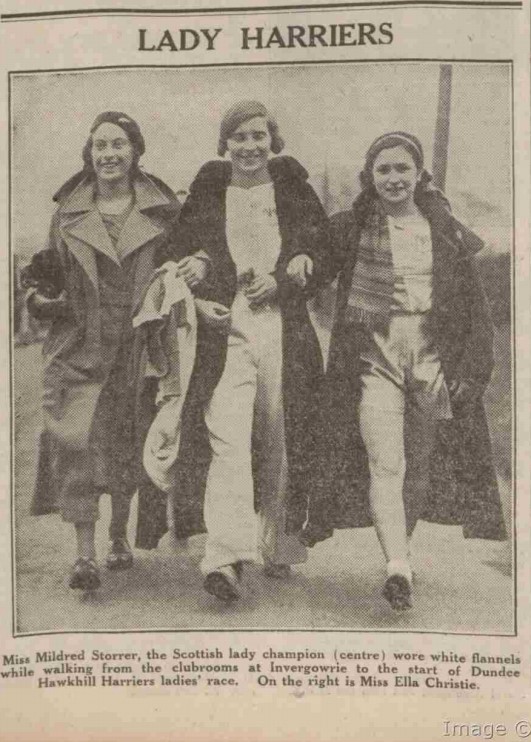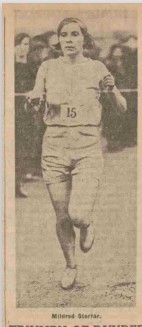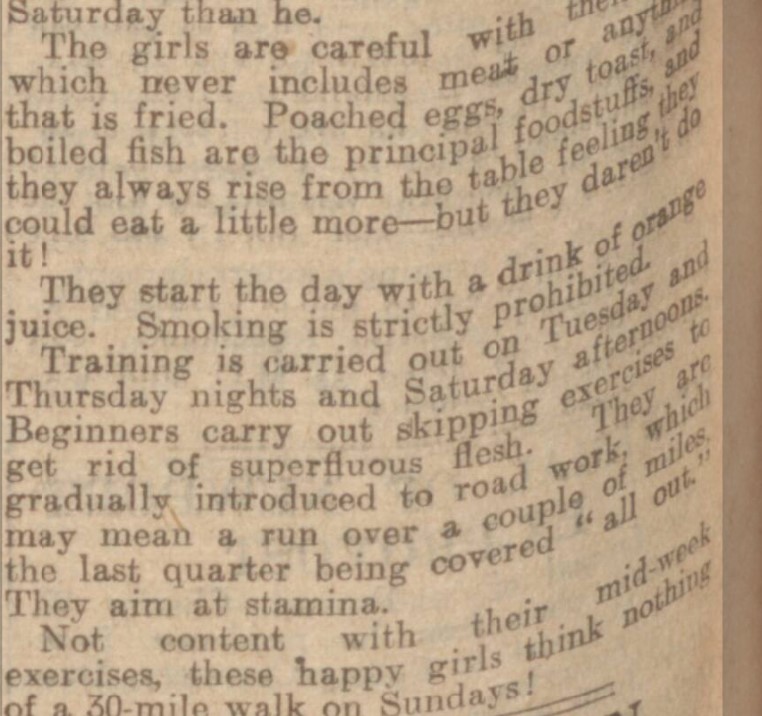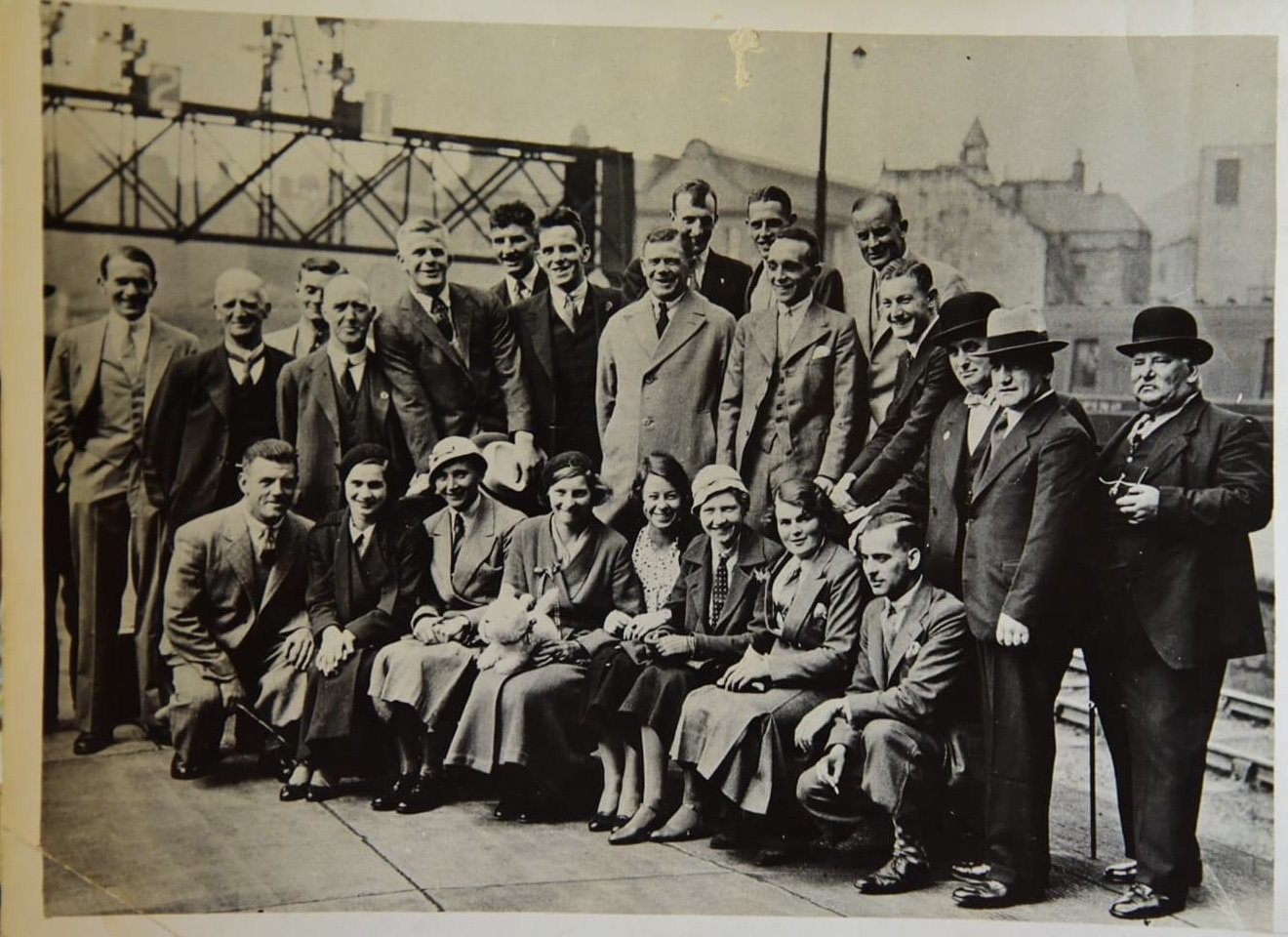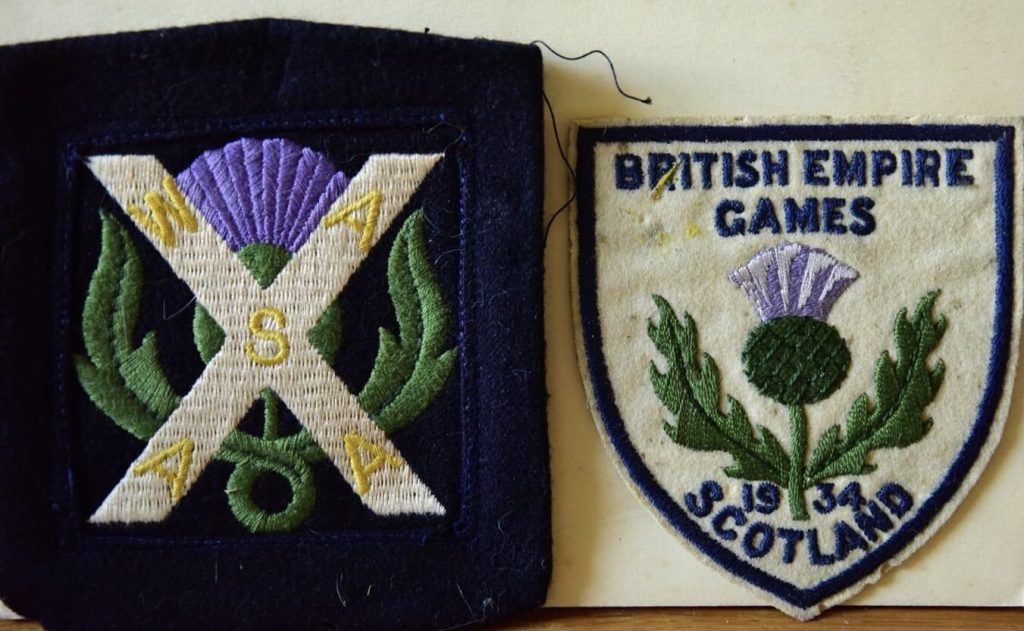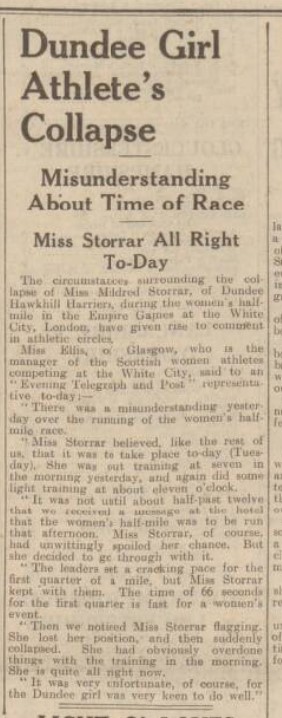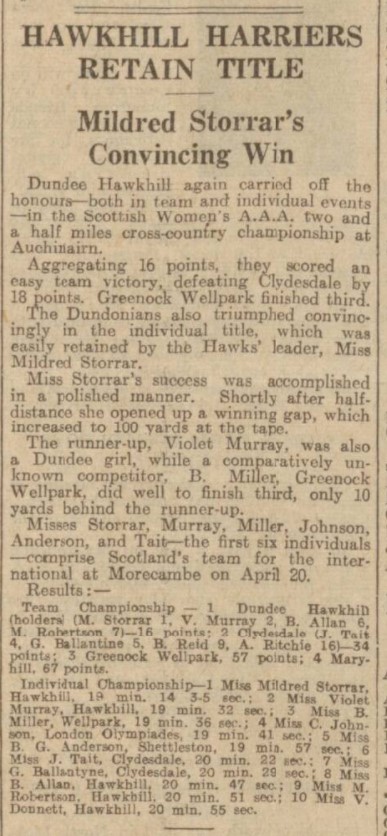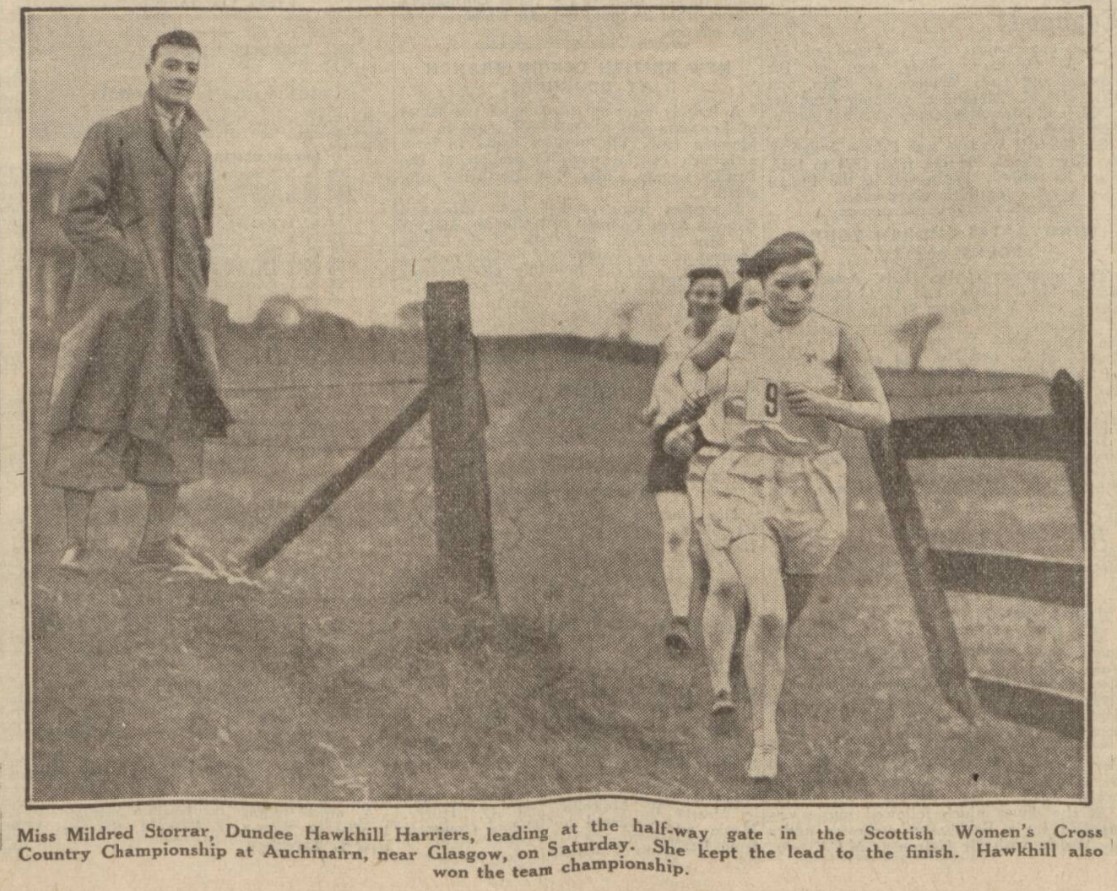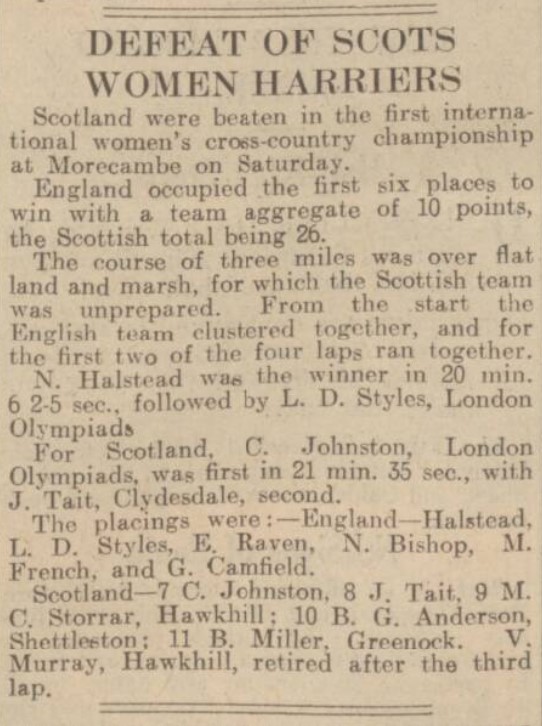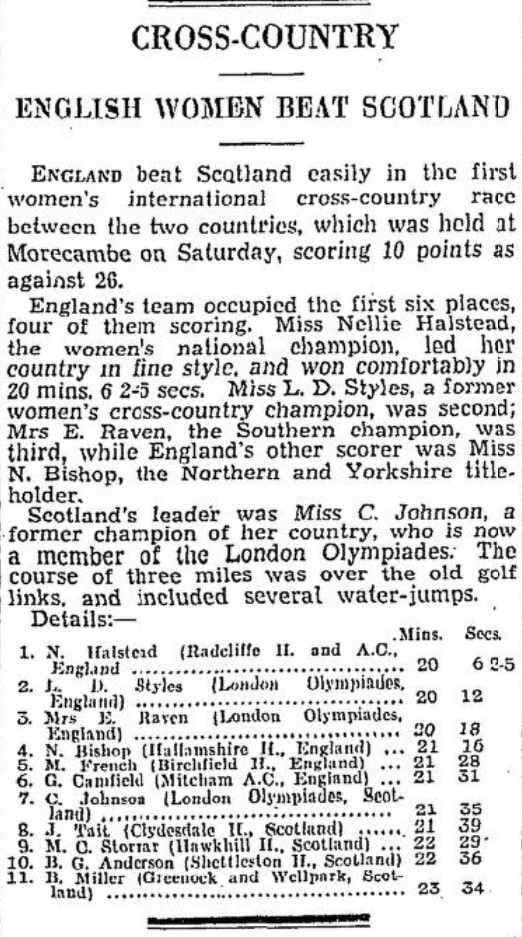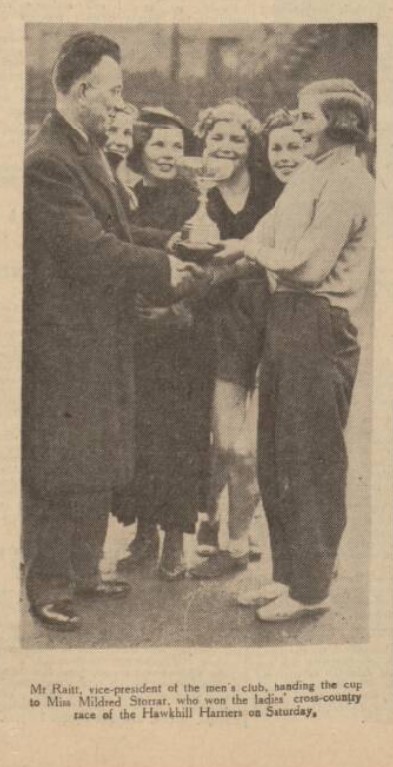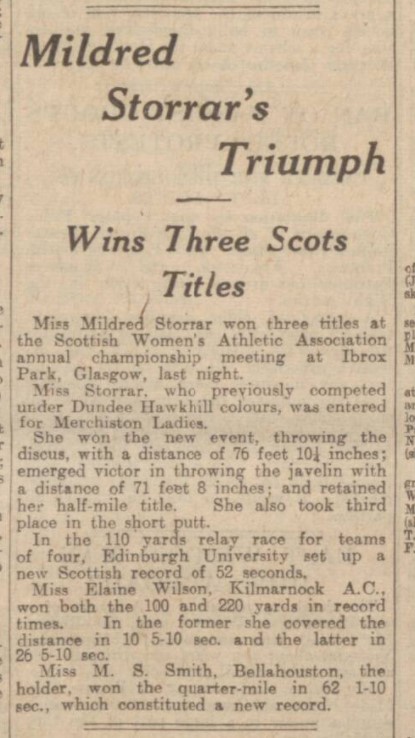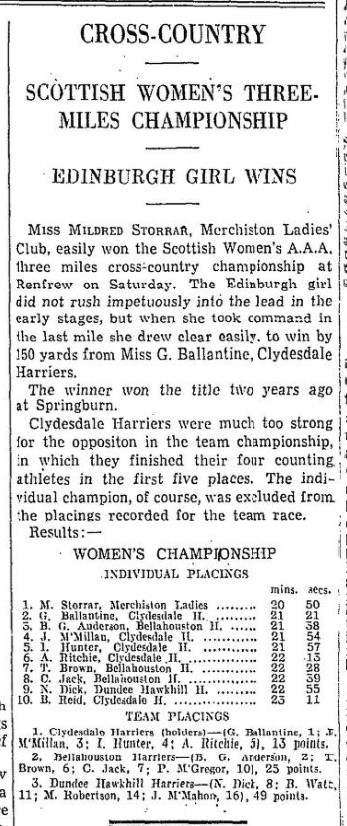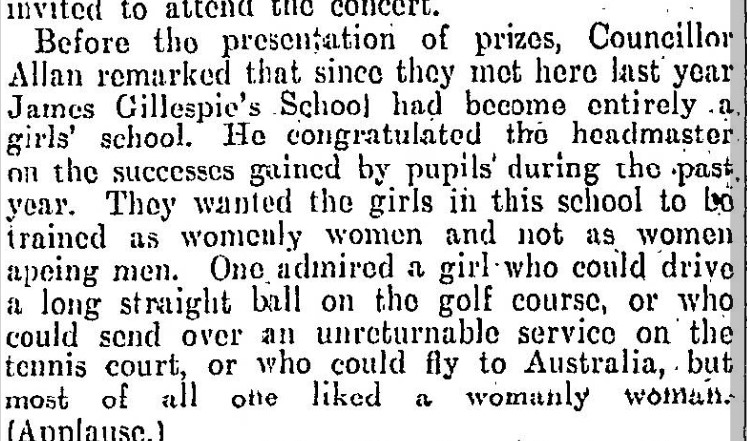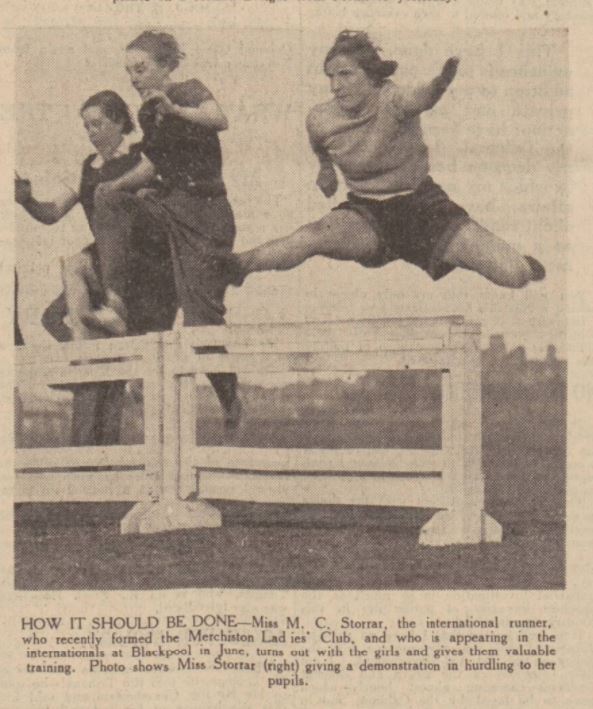Hawkhill Lady Harriers’ Scottish cross-country champion team. Back Row – Miss Tina Stevenson (trainer), Miss Helen Christie, Miss Elsie Patterson, Miss Jessie McKenzie (vice-president), Miss Bunty Carr (secretary) Front Row – Miss Bella Allan, Miss Peggy Laird (captain), Miss Catherine F Robertson (president), Miss Mildred Storrar (Scottish cross-country individual captain), Miss Vera Murray (Vice-captain).
The picture above was taken after Mildred had won her first Scottish |Cross Country title at the end of the 1933/34 season. A quick survey of her career tells that
- she went on to win it in 1934/35 and 1935/36 running for Hawkhill and again in 1937/38 representing Merchiston Ladies.
- On the track, having been second in 1933, she won the SWAAA 880 yards in 1934 and 35 as a member of the Dundee club and for the third time in 1936 as a member of Merchiston Ladies Club.
- There were other minor medals after the war – third in the shot putt and discus in 1951 representing Edinburgh Harriers.
- The high spot maybe had to be when Mildred ran for Scotland in the 1934 British Empire Games in London – the second British Empire Games and the first major Games to have an 880 yards race for women.
Her career is certainly worth a closer look. The picture below was taken for the local paper after the first individual (and team) victory in the national cross-country in 1934.
Born in Alberta, Canada on 9th March 1915, she is reported by one newspaper to have lived in Edinburgh but ran for Hawkhill because there was no club for her in Edinburgh. However that came about, she won her first SWCCU National Championships in season 1933/34.
In the summer of 1933, Mildred was first reported in the Dundee Courier newspaper edition of Saturday 17th June in a report on the SWAAA Championships at Ibrox the previous evening. No big write up, simply the result that she had been second to Constance Johnson of Maryhill Harriers. We find elsewhere that Alison Ritchie of Clydesdale Harriers was third – Constance won the title twice, Mildred was to win in the next three years and Alison would be the winner in 1937. There was a better press coverage when she ran in mid-July at the Aberdeen Football Club and North-Eastern Harriers Association Sports at Pittodrie Park. The SWAAA hurdles and quarter mile champion, Lilias SF MacKenzie and the report in the Press & Journal read, “although putting up a gallant fight in both events, Miss MacKenzie had to take second place in the finals of both 100 yards and half-mile. In both events her conqueror was Mildred Storrar, Dundee Hawkhill Harriers, to whom she had to concede handicap advantages.” In the 100, MacKenzie was off 1 yard with Storrar off 6 1/2″, and in the 880 MacKenzie was running from 12 yards while Storrar was off the 30 yards mark.
The ‘Evening Telegraph’ for 21st December in 1933 previewed the club’s Christmas handicap saying that the ladie’s race would be framed on Mildred Storrar – in other words, as top runner in the race, she would be running from scratch and the estimated difference from her normal running would determine the ‘start’ that the others would receive. The Women’s National Championship was held on 10th March at Bishopbriggs in Glasgow and the ‘Glasgow Herald’ report read: “The annual cross-country championships of the SWAAA were decided at Auchinairn on Saturday afternoon. There were changes in both team and individual honours, Dundee Hawkhill Harriers displacing Maryhill Harriers in the first and Mildred Storrar defeating Constance Johnston in the individual championship. This was the Dundee club’s first success as a team although Nan Robson, one of their members, won the individual title two years ago. The course of 1 1/2 miles was all cross-country with the exception of some 300 yards on road at the finish. Constance Johnston led all the way until the road was reached, Miss Storrar being on her heels. After the road was reached, the Dundee girl put in a spurt and breasted the tape five yards in front of the holder. There was a big gap between the pair and the rest of the field..”
The actual result was as follows: Individual:
1. M Storrar 9:46 ; 2. C Johnston 9:47; 3. J Tait (Clydesdale Harriers) 10:21; 4. BG Anderson (Shettleston Harriers) 10:26 ; 5. J Logan (Shettleston) 10:32; 6. V Murray (Dundee HH) 10:34
Team: 1. Dundee Hawkhill Harriers: M Storrar 1; V Murray 6; E Paterson 7; B Allan 9. 23 points
2. Maryhill Harriers: 2. C Johnson; S MacRae 10; K Robertson 12; C Wright 14. 45 points
3. Shettleston Harriers 45 points; 4. Clydesdale Harriers 56 points; 5. Bellahouston Harriers 68 points.
Not a huge margin, but a convincing enough win from a girl who had won handicap sprints the previous summer.
The ‘Courier’ was much more excited about the race pointing out that it was much more difficult than the usual, in the past they had been held over race courses but this time they included a ploughed field, ten fields and a steep hill. Approximately 70 years after the race I spoke to two Clydesdale Harriers women who had run in the race – Jean Tait and Georgie Ballantine – and they remembered Mildred as ‘ a big, strong girl’. Given that description of the trail used, she would have needed to be.
Maybe bigger than Jean Tait but the Courier described her as a 19 year old dairymaid who had joined the Hawkhill Harriers the previous summer because there was no club for her in the capital. ‘She assists her father in the running of the farm and is up every morning delivering the produce’ She was coached by her father but the others were looked after by Mr George Rudd who was quoted as follows:
A pretty strict regime but it would seem not too much in the way of running. There were not too many races on the calendar for women but the final race of the cross-country was the club’s own road race championships at the start of April with 15 runners. Mildred won by 15 seconds from Vera Murray and Cissie Riley (both on the same time); with E Christie fourth.
The big event for any athlete of talent was the British Empire Games to be held in London from 4th to 11th August It was the second of the series but the first with events for women. The first meeting had a range of sports available for men but women could only take part in swimming. The main selection event for the Games would be the Scottish Championships and Mildred Storrar was up for the challenge. The meeting was on Friday 15th June, and the result of the 880 yards was a victory for the Dundee runner. First, M Storrar second, N Aitken (Shettleston Harriers), third, I McGovern (Shettleston) winning time: 2:31 4/5th. The Scotsman reported: “The victory of M Storrar, the cross-country champion in the half-mile was a very easy one and had she been pushed her time would have been much better.
The Scotrtish team for the 1934 Empire Games: Mildred is in the centre of the front row.
She was chosen – one of only five Scottish athletes to go to the Games – and prepared for her event. Still only 19 years old, it was a big experience for her.
Photograaph and badges courtesy Janet Hardy
In the actual race, Mildred started but collapsed in the second lap and, although the official results place her seventh, she failed to finish She was Scottish cross-country champion, track half-mile champion, so what went wrong? The ‘Evening Telegraph’ reported.
It must have been a bitter disappointment for the Dundee woman but at 19 she must have thought that there would be another chance. The winter of 1935-35 was almost on her and there was the national to think of – and there would also be a women’s cross-country to contest too. In the Scottish women’s championship the club retained the Championship and Mildred won the title for the second time.
Came the international and the Scots were well beaten by the English squad. The rules were simple – six to run and four to count. the Scots team was simply chosen with the first six in the National selected. Mildred, twice Scottish women’s cross country champion finished behind two other Scots in 10th place. The Aberdeen ‘Press & Journal’ reported that the course was heavy and the runners had to clear several brooks, going on to report that the more experienced English runners filled the first four places. The ‘Courier’ reported:
‘The Scotsman’ reported in a bit more detail.
We might have expected a big, strong running woman like Mildred Storrar who worked on a farm to revel in a heavy cross-country trail, half a mile longer than the domestic championship, with several brooks to be crossed but she was a full 50 seconds behind Jean Tait and 54 behind Constance Johnson. It was a very good week end by all accounts with a very good meal in one of the best local hotels for both teams to mingle and enjoy a social evening together. It was now on to the track for summer 1935 and Mildred had a title to defend.
Towards the end of May, the annual contest between Dundee Hawkhill and St Andrews University, took place and Mildred Storrar won the Women’s 440 yards in a time reported as 7 1/5th seconds (!) from Margaret Kennedy of St Andrews and Vera Murray of Hawkhill. Mildred was also third in the 100 yards and in the high jump and was a member of the second p[laced relay team.
The SWAAA track and field championships took place at Ibrox Park on Friday 28th June on a warm, sunny and pleasant day. Mildred retained her 880 yards title in a time of 2 min 32 5/10th seconds from BG Anderson of Shettleston Harriers. BG Anderson was herself an interesting character – a very good runner on track and country she also ran for Maryhill Harriers and Clydesdale Harriers in the course of her athletics career. On this occasion however the reports merely said that Storrar had ‘won easily.’ Only two runners finished. She also won the discus throw – a preview of her two post war successes in the throws events.
In February 1936 The Dundee women held their club championship and Mildred won it for the third successive year.
That was first title that was retained and the big one was still to come. The National was held again on the Bishopbriggs course in Glasgow and the trophy was returned safely to Dundee. The individual trophy that was – and that was after a struggle with Clydesdale Harrier Jean Tait whom she finally defeated by only 4 seconds – but the team title went to Clydesdale Harriers who had their first four runners placed 2nd, 3rd, 4th and 7th against the Hawks 1st, 6th, 9th and 10th with Greenock Wellpark Harriers’ team in third with placings at 5th, 17th, 18th and 19th.
The first big meeting of the summer was the international against England France and Holland at Blackpool where she finished fourth in the 800 metres. but the BIG one was the SWAAA championshsips. The issue of the ‘Courier’ for Saturday 20th June reported on Mildred’s third consecutive SWAAA champioship victory at Ibrox the previous day but with a twist. It read:
The Edinburgh farmer’s daughter had switched from Dundee Hawkhill Harriers to Merchiston Ladies Club. The ‘Scotsman’ gave us a bit more detail in the results column after saying that
Note that the second placed athlete was Jean Tait of Clydesdale Harriers who had been second to her in the national cross-country championships. The move to Merchiston was probably a practical decision taken after four years of being driven to Dundee from Edinburgh and back for training and racing after an early rise to deliver the produce followed by a day’s work on the farm. It would have been difficult to cut the ties to Hawkhill after almost four years of membership and friend ships forged with the other team members.
Because of the adverse weather conditions – no teams from Aberdeen or Dundee travelled – the national championships at Bishopbriggs were not called a championship but a sealed handicap race was run instead with all the major places filled by the really unchallenged Clydesdale Harriers. When it came to the SWAAA Championships in 1937, Mildred Storrar competed only in the discus where she won for the second year in succession. It is not clear why she did not turn out in the half mile, she may have been injured but where the ‘Courier’ reported in some detail on her progress, the Scotsman, a bigger paper with a bigger circulation, was not as forthcoming.
She was however back in action over the longer distances by the time of the 1937/38 cross-country season. This time, she was running as an individual since there was no Merchiston team forward – Clydesdale had a team forward and BG Anderson had by now migrated to Bellahouston Harriers. The Scotsman report is below.
Clydesdale with four in the first six won the team race – had BG Anderson stayed with the club with whom she had already won team gold, she would have had another and the club would have had five in the first six. If you are wondering what happened to Jean Tait – well she was third under the name of Mrs Jean McMillan having married fellow Clydesdale Harrier Andy McMillan.
Mildred was 24 in March 1938 at a time when women’s sporting careers tended to be relatively short. She was to be no exception. The events on the continent at the end of the 1930’s maybe hastened her departure but 1938 was her last season at the top of the Scottish women’s endurance running tree. There were not very many events for women at the time and the Scotsman did not report on women’s sport as much as the ‘Dundee Courier’ did either. For instance the Hawkhill women’s club championships were reported every year while the same is not true of the Merchiston Ladies Club. As an example of the attitude to women’s sport in the community at large, the following extract from an article on the school prize giving where Mildred won the athletics prize is informative.
No results were found in searches for Mildred Storrar in either the Scotsman or the Courier for 1939. She did compete after the war but to nothing like the pre-war standard and although she did win some medals at the SWAAA championships in 1951 and 1952 they do not appear to be of equal significance to those that she won so well and so profusely before 1939. It would be interesting to find what her involvement after the war had been but unfortunately it is not an easy trail to pick up, and the current difficulties with government restrictions do not make it any easier.
Alex Wilson sent the above photograph showing Mildred in hurdling action. There are two things about the picture that strike one immediately. The first is the remark that she ‘recently formed the Merchiston Ladies Club’ which adds to our store of information about her reasons for leaving Dundee Hawkhill Harriers. The second, as Alex himself comments, is that she would have been a very good pentathlete. We know from other results that she was a good sprinter at distances up to 440 yards, an international class half-miler, a medal winning shot and discus performer, a high jumper and here she is as a hurdler. More information about her post-war athletics involvement would be invaluable.
Mildred Storrar died in 1985 in Cardenden in Fife at the early age of 70 and is buried in Bowhill Cemetery.
